The Wheelchair Guide
Your Wheelchair and Mobility Scooter Resource
Evaluating a Manual Wheelchair for Safety and Comfort
July 6th, 2009
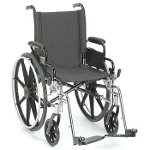 When ordering a new wheelchair, ensuring that the wheelchair fits the physical requirements of its user is very important for health and safety reasons, but it can also effect mental health.
When ordering a new wheelchair, ensuring that the wheelchair fits the physical requirements of its user is very important for health and safety reasons, but it can also effect mental health.
Ordering a wheelchair is not a decision that should be taken lightly and it is important that the wheelchair user has plenty of input during the process. Once a wheelchair has been ordered, it should constantly be reevaluated to ensure that it is safely meeting the needs of its user. This should be done both the wheelchair user, as well as a doctor.
Once a persons new wheelchair arrives, the prescribing doctor should evaluate the wheelchair to unsure that it is a proper fit for its user. There are a number of adjustments that can be made to the frame to fine-tune the wheelchair, so that the user can gain the maximum mechanical benefit from the wheelchair.
For manual wheelchairs, since they require a good deal of upper body strength to use, the comfort of the arms in relation to the manual wheelchairs drive wheels is very important. This means, that when in the starting position, the users arms should basically be at rest. This will help to prevent cramps and reduce the effort required to use the wheelchair.
The cushion and seat of the wheelchair should also be treated as a single unit, otherwise, you risk the user being too high or low when the cushion is added. Proper seat height is important, because if the wheelchair is too high, not only will it be uncomfortable, but it will also reduce the efficiency of the wheelchair, which makes it much harder to use. If the seat is too low, it can cause uneven weight distribution.
The height of the backrest is also very important. If it is too high, it can restrict the movements of the shoulder and upper body. However, a backrest that is too low will not provide enough support and can result in poor posture.
The overall width of the wheelchair is another important consideration, because a wheelchair that is too wide can result in the user developing poor posture. This is because the individual will have to lean side to side to reach the wheels. Of course, a wheelchair that is too narrow can cause discomfort and sores, so finding the correct median is essential.
A seat that is too deep can also cause problems, as it can reduce circulation and attribute to poor posture. It can also be dangerous, because the weight of the user is not as evenly distributed, resulting in less weight on the thighs.
Selecting the Right Wheelchair
July 2nd, 2009
 There are a number of decisions that go into prescribing a manual wheelchair and this decision should not be made lightly. This is because a wheelchair will be used daily and an improper fit could result in joint deformities, bruising, poor posture, circulation problems, and even pain. However, these problems can be avoided by ensuring that the wheelchair fits the user.
There are a number of decisions that go into prescribing a manual wheelchair and this decision should not be made lightly. This is because a wheelchair will be used daily and an improper fit could result in joint deformities, bruising, poor posture, circulation problems, and even pain. However, these problems can be avoided by ensuring that the wheelchair fits the user.
Size of the User
One of the most important considerations is the age of the wheelchair user, their size, and their weight. Wheelchairs come in a variety of sizes and so, it is seldom a problem finding one to fit an individual.
However, it is imperative that the seat is wide enough to accommodate their frame, the armrests do not rub their arms or cause discomfort, the backrest is not too high or too low, and the wheelchair can support the weight of the occupant. The height of the occupant is also important, so the wheelchair is not raised too high or low off of the ground.
Health and Condition of the User
The physical health and type of disability the new wheelchair user has is also a very important part of deciding what type of wheelchair will be the best choice. Since manual wheelchairs require good deal of upper body strength to use, they will not be the best choice for some, necessitating an electric power chair. Other considerations are the users ability to support their neck, how much flexibility they have in their legs, and circulation concerns, which could require the user to keep their feet elevated or have a reclining back.
Needs of the User
While the physical condition and attributes of the wheelchair user are essential, it is also imperative that the wheelchair can do what the user needs it to, so the needs and preferences of the wheelchair user should always be considered. For example, it should be determined if the user will be using the wheelchair only at home, at work, primarily outdoors, or a combination of all three. Other considerations include whether someone else will be pushing the wheelchair, how easy the wheelchair is to transport, and how the individual will transfer into and out of the chair.
Cost of the Wheelchair
Typically, the final consideration before actually ordering the wheelchair is the overall cost and purchasing power of the user. The order should be fine tuned to remove any unneeded features, which can add to the cost. The option to lease, buy, or rent should also be considered, as well as insurance or Medicare costs.
Ensuring that the wheelchair fits the specific needs and requirements of its user is imperative, not only for safety and health concerns, but also because the acceptance of a wheelchair by its user can affect their mental health.
Sports Wheelchair Parts Diagram
June 23rd, 2009
There are a great number of wheelchairs on the market and it is very important to find one that will fit the needs of its user. The sport wheelchair, or ultralight wheelchair, is very popular, both by people who are very active and those who simply find it easier and more comfortable to use.
*Please Note that some of the items below are not present in the picture, because they are not usually found on a sports wheelchair.
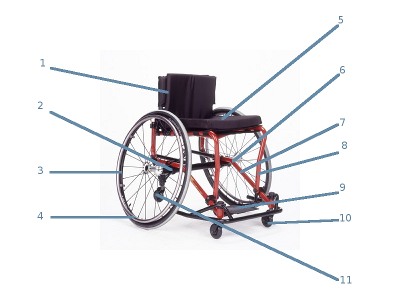
- Backrest
- Rear Axle
- Rear Wheels
- Handrims
- Seat
- Frame
- Traverse Bar
- Front Rigging
- Footrests
- Front Casters
- Anti-Tip Casters
- Brakes
- Tipping Levers
- Seatbelts
- Push Handles
- Upholstry
- Armrests
- Metal Skirt
1. Backrest: The backrest of a sports wheelchair is usually lower than a conventional wheelchair. Typically the backrest will be between 11†and 15â€. The backrest is also usually adjustable and models are also available that span 7†to 11†and 15†to 19â€. A lower backrest can allow for increased upper body movement.
2. Rear Axle: While on a conventional wheelchair, the axle is located directly below the backrest, many sports wheelchairs have adjustable axles. They can be positioned closer to the front of the chair, reducing the wheelbase and making the wheelchair more maneuverable. While typically much more maneuverable and easier to push, a smaller wheelbase also reduces the stability of the wheelchair. To increase stability, at the expense of maneuverability, the axle can be moved backwards towards the rear of the wheelchair. It also makes it a little harder to push, but increase the power of the stroke. Instead of a moving axle, some sports wheelchairs have a moving seat instead.
3. Rear Wheels: The rear wheels are usually the same size as on conventional wheelchairs, but sometimes for racing larger wheels are used. They feature sealed precision bearings and are designed to be as lightweight as possible. This makes the wheelchair easier to move and reduces friction. They also usually feature a quick release button, so the axle can be moved or wheel replaced quickly and easily. Most use spoked wheels, although some sports wheelchairs have solid molded rims.
Typically pneumatic tires are used, often allowing for a much higher pressure than traditional pneumatic tires. Pneumatic tires are great for outdoors, because they provide better shock absorption outdoors. Like racing bikes, the tires are often very narrow.
Often, the camber of the wheel, its angle, is often adjusted, much like you would adjust a sports car, with the bottom of the wheel farther out than the top. This brings the wheels closer to the users body, allowing for more energy efficiency. A wider wheelbase also offers the advantage of a more stable wheelchair that is also easier to steer.
This can pose a problem when indoors when dealing with narrow doorways and makes transporting the wheelchair more difficult. Some now allow the camber to be quickly adjusted to a “toe in†mode for indoor use though.
4. Handrims: The handrims are typically coated in foam that is covered in vinyl, although the rim itself is made of metal. This makes it easier to grab, however the vinyl can be very slick and result in finger burns. More or less padding can also be added, to deliver a variety of grip sizes.
Often smaller handrims are used, which require more energy to get started, but allow for a higher top speed. The smaller handrims also allow for the individual to maintain their speed easier. In many regards the size of the handrim is much like the different gears on a bike.
Sometimes for those with very limited upper body strength or mobility, small extensions are added to the handrail, which extend away from the wheelchair at an angle, making the wheels easier to turn.
5. Seat: The seat often has pieces of velcro attached to it, allowing cushions and bags to be attached. The lower backrest of the seat allows for a greater range of movement and slightly elevates the knees, improving stability.
6. Frame: The frame of a sports wheelchair is made of metals that are very lightweight, such as aluminum, titanium, and graphite. Often, the entire wheelchair will weigh only 25 pounds, which is about half of what a conventional wheelchair weights. There are some, however, that can weigh as little as 15 pounds. The lighter the frame, the easier it is to propel.
Traditionally the frame of sports wheelchairs had been rigid. This improved its performance and made it much sturdier, but it also made it harder to transport. The seat would have to be folded forward and the larger rear wheels would be removed. However, as of late, several manufacturers have begun making folding sports wheelchairs, which makes transportation much easier.
7. Traverse bar: The traverse bar replaces the crossbars found on conventional wheelchairs and helps make the frame sturdier. On folding sports wheelchairs, the frames are equipped with locks to prevent it from folding unless needed.
8. Front Rigging: The front rigging refers to the footrest and the bars that connect it to the frame. Traditionally, the front rigging was not detachable, which improved the stability of the frame. However, this could make transferring into and out of the chair more difficult, some some sports wheelchairs now feature detachable and swing away front rigging.
9. Footrests: The footrest is typically one piece and made of several metal tubes, instead of a platform. It is usually closer to the frame than conventional wheelchairs, reducing the sports wheelchairs turning radius.
10. Front Casters: The front casters are typically made out of solid polyurethane, although some use pneumatic or solid rubber tires. The casters are smaller than those on a conventional wheelchair, usually only 4†to 5†in diameter. However, on racing wheelchairs larger front casters are often used.
11. Anti-Tip Casters: Anti-Tip casters prevent the wheelchair from tipping backwards completely and are often not included on newer wheelchairs.
12. Brakes: Most sports wheelchairs do not have brakes, although some choose to use them. If used, scissor brakes are most popular and mounted lower down on the frame, so the users hand does not become entangled when pushing or the brake accidentally activated. (Not Pictured)
13. Tipping Levers: Typically the tipping lever, which makes it easier for someone pushing the wheelchair to tip the wheelchair backwards and navigate curbs, are much smaller than those on conventional wheelchairs. (Not Pictured)
14. Seatbelts: Seatbelts are usually available for most sports wheelchairs as an option. Some wheelchair users that are very active will use a safety harness to provide more support. (Not Pictured)
15. Push Handles: Many sports wheelchairs do not have push handles, because of the added weight. Instead, fabric straps are added to the back of the seat, to provide a handhold. Some, however, do have push handles. (Not Pictured)
16. Upholstry: Most sports wheelchairs have reinforced nylon or darcon upholstry. This is very lightweight and strong, but unlike vinyl, it is not as easy to clear. (Not Pictured)
17. Armrests: Most sports wheelchairs do not have armrest, which reduces the weight, while allowing the user a better pushing angle. It also increases the users range of upper body movement. (Not Pictured)
If armrests are present, they are usually lightweight and removable. Typically they are not strong enough for the user to use them to transfer into and out of the wheelchair.
18. Metal Skirt: A metal skirt is also usually not present, for both wheelchairs with and without armrests, so the user will risk dirtying their clothes or catching them in the wheels. (Not Pictured)
Other Types of Sports Wheelchairs
There are many different popular wheelchair sports and almost all of these types of sports use a slightly different wheelchair design. For example, the footrest and front rigging of a wheelchair that will be used for wheelchair basketball has a built in foot guard to add more protection. Wheelchairs for wheelchair rugby have an even more protective front guard, as well as more protection around the wheels.
Wheelchairs that are used for racing are elongated to provide stability, so the front wheels often extend several feet from the wheelchairs seat. Since there is so much diversity among the design of sports wheelchair, it is important to decide what you want to use the wheelchair for and to speak with a professional or other wheelchair user to determine what type of wheelchair will be best. It is also not uncommon for many wheelchair users to prefer the design of a sports wheelchair, even if they do not intend to directly use it to play sports.
Increasing Accessibility With a Mobility Scooter
June 10th, 2009
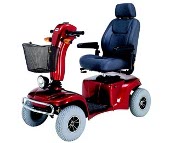 Often, for seniors walking for an extended period of time can become very difficult. Many times, this is not a big issue when at home, but it can make going anywhere, even to the grocery store, very difficult. To make it easier to get around, the mobility scooter is one of the more popular mobility vehicles available for a senior.
Often, for seniors walking for an extended period of time can become very difficult. Many times, this is not a big issue when at home, but it can make going anywhere, even to the grocery store, very difficult. To make it easier to get around, the mobility scooter is one of the more popular mobility vehicles available for a senior.
While wheelchairs have been used for thousands of years, the mobility scooter is fairly new, dating back only about fifty years. Mobility scooters also use a design that is very different from that of a wheelchair. One of the major differences is that due to the way a scooter is designed, you can not drive it directly up to a table or desk, so will likely have to transfer to a regular chair when eating or working.
Typically, the mobility scooter will have a rectangle shaped base, with wheels at the front and back. A chair is mounted slightly off center, positioned more towards the back of the base. Depending on the chair, it could offer a very simple lightweight design, or it could be a luxurious captains chair, with a reclining back.
A set of handlebars, called the tiller, extends from the front of the base and can be moved closer to the chair as needed. The tiller is used to control the direction and acceleration of the mobility scooter. A headlight, turn signal, and basket are also often attached to the tiller. They also typically have keyed entry, to protect the scooter from unauthorized use.
Mobility scooters are very popular, because they allow an individual to move easily over relatively large distances, with little physical effort. The range varies by model, but most adult scooters can travel at least five miles on a signal charge, with some capable of traveling more than 30 miles without requiring a charge. It is usually possible to purchase an extra battery pack for the scooter, which effectively doubles the range of the device. When one battery wears down, the battery can be taken out and charged, with the other battery pack being added. Most people will not require an extra battery pack, but it might be a good idea for those who are always on the go and don’t want to be stuck waiting for their mobility scooter to recharge.
Since the mobility scooter is battery powered, it can safely be used indoors or outdoors, although some are better suited at outdoor use than others. Typically, four wheel scooters provide a more stable platform for outdoor use and three wheeled scooters have a smaller turning radius, so are better for indoor use. Most will preform equally well over tightly packed terrain though, so for many people the extra stability offered by a four wheeled adult scooter is negligible.
For the mobility challenged senior, an electric mobility scooter is a very valuable tool that helps increase their mobility. These devices are available to accommodate people of all sizes and can be a valuable asset for those who have problems walking for extended periods of time.
Electric Wheelchairs
June 4th, 2009
The wheelchair is one of the oldest types of medical equipment known to man. Its uses can be traced back thousands of years and every year, the wheelchair greatly improves the lives of the mobility challenged. The electric wheelchair, on the other hand, is a much newer device and has only been available for about sixty years.
The first electric wheelchairs, which were developed during the nineteen-fifties, were simply manual wheelchairs that had been outfitted with an electric motor. They have changed a great deal since then, although there are a few that still share a similar design to these early electric wheelchairs. Most however, have a power base, which contains the electric motor, wheels, and batteries, with a chair mounted to the top of the base.
To control the wheelchair, a simple joystick is attached to the arm of the chair and the wheelchair user can simply push the joystick in the direction they wish to go. Most will also have a button for a horn, a battery meter, and a speed adjustment mounted in the armrest.
While for many people the joystick will provide an adequate control system, there are some who lack the ability to use this type of control and must instead use an alternate wheelchair control system. For instance, it is possible to control the wheelchair with head movements, breath, or even with a remote control. Currently, there are several companies working on a brain controlled wheelchair as well, which will eventually allow the wheelchair user to control their wheelchair with thoughts.
There are many different models of electric wheelchair available and a number of different manufacturers as well, but most electric wheelchairs can usually be classified as either rear wheel drive wheelchairs or mid-wheel drive wheelchairs.
A rear wheel drive wheelchair usually has 4 wheels and the two rear wheels are responsible for moving the wheelchair. They provide a very sturdy and stable base, because the weight is evenly distributed across the four wheels.
A mid-wheel drive wheelchair usually has 6 wheels. The set of wheels in the middle is used to move the wheelchair and the other wheels, which are located on the front and back of the base, are used to provide stability. A mid-wheel drive wheelchair is incredibly maneuverable, however the weight is not as evenly distributed, so it will not be as stable as a rear wheel drive wheelchair.
While the rear wheel and mid-wheel drive wheelchairs are the most common, there are also foldable electric wheelchairs, which use a frame that is similar to that of a manual wheelchair. These are popular for traveling, but lack many of the features of the other types of electric wheelchairs.
The electric wheelchair has greatly evolved over the last fifty years and today provides a very reliable and dependable way to allow a mobility challenged individual to get around.
What are Power Chairs?
June 2nd, 2009
The wheelchair is easily one of the most important medical devices of all time and its roots can be traced back thousands of years. Today, more and more people are using electric wheelchairs.
Electric wheelchairs were first developed in the nineteen-fifties when an electric motor was added to a manual wheelchair. They quickly became popular because a manual wheelchair requires a great deal of physical effort to use and a lot of upper body strength, making them impossible to use for many who are mobility challenged. An electric wheelchair, on the other hand, can be moved by only lifting a finger and there are a number of alternate wheelchair control systems available as well, such as a system that allows the wheelchair to be controlled by the breath of the user.
There are many manufacturers of electric wheelchairs, but two of the most well known are Golden Technologies and Pride Mobility. Both of these companies offer a wide assortment of home medical equipment, including a number of different electric wheelchairs. There are of course many other manufacturers, including ShopRider, so it is a good idea to explore all of your options when shopping for an electric wheelchair.
While there are many different models of electric wheelchairs available, they can typically be classified as either rear-wheel drive, mid-wheel drive, or travel wheelchairs.
Rear-wheel drive wheelchairs are propelled by their rear wheel and the weight of the user is evenly distributed across the electric wheelchairs base. Mid-wheel drive wheelchairs feature three rows of wheels, with the row in the middle being responsible for moving the wheelchair. A mid-wheel drive wheelchair is much more maneuverable than a Rear-wheel drive wheelchair, but the weight is not as evenly distributed, so it does not provide as stable of a platform. For most, the difference is negligible, but in some outdoor situations and for those who require a higher weight capacity, the rear-wheel drive wheelchair might be the best choice.
Travel wheelchairs come in several different designs, but are lighter and easier to transport than other electric wheelchairs. Some are designed so that they can be taken apart into easy to manage pieces and others share a design similar to a steel tubed manual wheelchair, allowing them to be folded up when not in use. They typically have a shorter range and fewer features, but can usually be transported without requiring a vehicle wheelchair lift, which would typically be required to transport non-travel wheelchairs.
For millions of people across the globe, the electric wheelchair allows for increased mobility and accessibility, allowing them to effortlessly move around.
Medicare and Mobility Scooters
May 29th, 2009
Medicare is a federally funded insurance program available to most seniors over the age of 65. In addition to covering the types of things you would expect a private insurance plan to cover, Medicare also covers the cost of many types of home medical equipment. Medicare refers to this equipment as Durable Medical Equipment. Mobility Scooters are covered by Medicare and fall into the category of durable medical equipment.
While Medicare does cover Mobility Scooters, there are a few requirements the insured must meet before ordering a mobility scooter. The main requirement is that the scooter is needed for use both in the home and away. If the insured can get around their home without the scooter and only need it when away from home, it would not be covered.
The other main requirement to receive Medicare coverage of a mobility scooter is that a doctor prescribes the scooter as part of a treatment plan. It is important to speak with your doctor prior to ordering the scooter, to ensure that you are eligible to receive a prescription for the device.
If the insured meets these requirements, then Medicare will typically cover 80% of the cost of the mobility scooter. Most mobility scooter dealers will bill Medicare, so once the insured has a prescription, the process typically goes very smoothly. It is also possible to purchase the mobility scooter first and receive reimbursement later, but always make sure you meet the requirements for Medicare reimbursement before doing this.
While almost all of those who use traditional Medicare will be eligible to receive durable medical equipment, such as mobility scooters, those who use a Medicare Advantage Plan, the process might be a little different. Medicare Advantage Plans are optional plans that are still funded by the federal government, but private insurance companies administer the programs. As a result, while a Medicare Advantage Plan will still cover the same things as Medicare, they often go about it in a different manner.
For those who use a Medicare Advantage Plan, it will be necessary to consult the documentation provided by the private insurance company to see how mobility scooters are covered and what the process is to receive reimbursement.
Medicare and Electric Wheelchairs
May 27th, 2009
Medicare is a federally funded insurance program available to most Americans over the age of sixty-five. It is designed to provide affordable health care and covers the cost of doctors visits and prescriptions. In addition to providing coverage similar to that of private insurance, Medicare also covers the cost of Durable Medical Equipment, which is a broad category consisting of many types of home medical equipment.
Wheelchairs, both manual and electric, fall into the category of Durable Medical Equipment and are typically covered by Medicare.
While electric wheelchairs are covered by Medicare, the insured must meet several requirements in order for the device to be covered. One of the main requirements is that the individual is unable to use a manual wheelchair. They must also be able to transfer into and out of the wheelchair and able to operate the electric wheelchair in a safe manner.
In addition to the above physical requirements, the electric wheelchair must also be prescribed by a doctor as part of a treatment plan. In most cases, Medicare will only cover one electric wheelchair every five years, so if they have previously provided reimbursement for a wheelchair, it might not be available.
With a doctors prescription and assuming the insured meets the other physical requirements, Medicare will typically provide reimbursement for up to 80% of the cost of an electric wheelchair. Some companies will directly bill Medicare, although it is usually also possible to buy the electric wheelchair first and apply for reimbursement later. However, if you go this route ensure that you meet Medicare’s requirements first and will be eligible to receive reimbursement.
For those who use a Medicare Advantage Plan (MMA) the rules for reimbursement may vary, so it will be necessary to check with the company that runs this plan. A Medicare Advantage Plan is available to those eligible for Medicare and covers the same things as traditional Medicare, but is run by a private insurance company. As a result, the way some things are covered and reimbursement received can be a little bit different, but Medicare Advantage Plans are required to cover the same things as traditional Medicare.
Mobility Scooters for Seniors
May 22nd, 2009
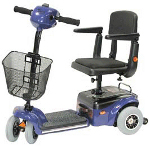 One of the most popular, if not the most popular, mobility aids for seniors is the mobility scooter. Mobility scooters were first developed during the 1960′s and share many similarities with the electric wheelchair.
One of the most popular, if not the most popular, mobility aids for seniors is the mobility scooter. Mobility scooters were first developed during the 1960′s and share many similarities with the electric wheelchair.
An electric motor propels the mobility scooter and it uses one or more batteries, much like a power chair. Often they also share a similar, if not identical captains chair, which includes the same types of features, such as a reclining back, electric lifting system, and swivel controls to make exiting the mobility vehicle much easier.
Like the other two kinds of mobility vehicles, mobility scooters also feature anti-tip casters to prevent the device from tipping over backwards.
However, the physical design of a mobility scooter is actually much different than that of a wheelchair, both electric and manual. This is because they have a much longer wheel base and the captains chair is mounted on the rear of the base.
Mobility Scooter Control Systems
Instead of an armrest mounted joystick, like is used on an electric wheelchair, a mobility scooter is controlled by a set of handlebars, which extends from the front of the scooters base. These handlebars, which are referred to as the tiller, can be adjusted to accommodate riders of different sizes. This allows the mobility scooter’s tiller to be brought closer or moved farther from the captains chair.
Depending on the model of scooter, the tiller might have a headlight, turning signals, battery meters, keyed entry, and troubleshooting gauges on it. Due to the location of the tiller, a mobility scooter can not be driven directly up to a table or desk.
Three Wheeled and Four Wheeled Mobility Scooters
There are a number of different types of mobility scooters available, with many different models available. There are also several ways that an electric mobility scooter can be classified.
One of the most common ways to classify a mobility scooter is by the number of wheels it has. 4 wheeled mobility scooters have two wheels in front and two wheels in the rear. This provides more stability, because as in the case of a rear wheel drive power chair, the weight of the occupant is spread out more evenly. This makes a 4 wheeled scooter more stable than a 3 wheeled scooter.
While a three wheeled mobility scooter might not be as stable as a four wheeled scooter, they are typically much more manuverable and have a turning radius that is considerably smaller than that of a four wheeled scooter. This makes a 3 wheeled scooter preferrable for indoor use. They are also typically lighter in weight.
Different Mobility Scooters for Different Uses
The other way that mobility scooters are classified is by their intended use. For example, there are travel scooters, heavy duty scooters, and traditional scooters.
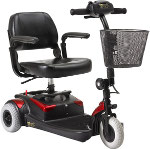 Travel scooters are designed to be as light weight as possible, so they can be taken on vacation or away from the home. They are also designed so that they can be easily disassembled, with all of the pieces being a manageable weight. Often the heaviest piece weighs less than 30 pounds, so most people are able to disassemble it and place it in the trunk of their car or rear seat of their vehicle.
Travel scooters are designed to be as light weight as possible, so they can be taken on vacation or away from the home. They are also designed so that they can be easily disassembled, with all of the pieces being a manageable weight. Often the heaviest piece weighs less than 30 pounds, so most people are able to disassemble it and place it in the trunk of their car or rear seat of their vehicle.
Most travel scooters are three wheeled, as this helps reduce the overall weight of the electric scooter. They also have fewer features, like a scaled back captains chair and no running lights, to further save weight.
Travel scooters do not have the same weight support or range that you could expect from other scooters, but for vacation they can be a great choice.
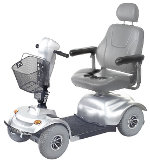 On the opposite side of the spectrum you have heavy duty scooters. A heavy duty mobility scooter is designed to be as rugged and durable as possible. They have the highest weight support, usually feature reinforced bumpers, larger tires, and are packed with features. They are designed, as the name implies, to be used over rough outdoor terrain. Typically, most are four wheeled as this provides the most stability, but there are a few three wheeled heavy duty scooters.
On the opposite side of the spectrum you have heavy duty scooters. A heavy duty mobility scooter is designed to be as rugged and durable as possible. They have the highest weight support, usually feature reinforced bumpers, larger tires, and are packed with features. They are designed, as the name implies, to be used over rough outdoor terrain. Typically, most are four wheeled as this provides the most stability, but there are a few three wheeled heavy duty scooters.
Heavy duty scooters also usually have a very high top speed, large per charge range, and can be a great deal of fun to drive.
While great for outdoor use, since a heavy duty scooter is typically much larger than other electric scooters, it can not be used in some indoor situations and has a much larger turning radius. It also weighs a great deal more so taking it apart and placing it in a vehicle might not be an option for most people. Heavy duty electric scooters are also the most expensive type of mobility scooter.
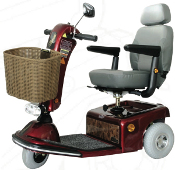 All other mobility scooters fall into the category of traditional scooter. These come in a variety of sizes and while they have many more features than a travel scooter, they have fewer than a heavy duty scooter. Typically though, they will have things like running lights. They come in either 3 wheeled or 4 wheeled designs.
All other mobility scooters fall into the category of traditional scooter. These come in a variety of sizes and while they have many more features than a travel scooter, they have fewer than a heavy duty scooter. Typically though, they will have things like running lights. They come in either 3 wheeled or 4 wheeled designs.
When compared to travel scooters, traditional scooters offer increased weight support, range, top speed, stability, and durability. Like heavy duty scooters, the weight of a traditional scooter often makes disassembling it not an option, because the lightest piece can often weigh well over 70 pounds.
Seniors and Mobility Scooters
Price wise the cost of a mobility scooter usually falls in the middle, between a manual wheelchair and electric wheelchair. They are easy to use and have a greet range, so can be a good choice for a senior who has difficulty walking.
Due to the location of the tiller, you are not able to drive a mobility scooter directly up to a table, which means that some mobility is required of the user in order to get the most benefit out of a mobility scooter.
For someone who can walk, but not for extended periods of time, a mobility scooter would be a good choice. However, for someone who can not walk, a mobility scooter might not be a good choice.
Electric Wheelchairs for Seniors
May 21st, 2009
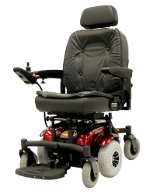 Electric wheelchairs, which are often also called power chairs, offer the advantage of a manual wheelchair, in that they are very maneuverable. However, unlike manual wheelchairs, power chairs are powered electronically, so they can typically be operated very easily, requiring very little physical activity of the senior.
Electric wheelchairs, which are often also called power chairs, offer the advantage of a manual wheelchair, in that they are very maneuverable. However, unlike manual wheelchairs, power chairs are powered electronically, so they can typically be operated very easily, requiring very little physical activity of the senior.
A simple joystick control scheme is most popular for controlling electric wheelchairs, which allows the senior to simply push the joystick. The joystick, which is attached to the arm of the power chair, then moves the wheelchair in the direction they wish to travel. Of course, there are a number of alternate wheelchair control systems available as well, including breath controlled systems and remote controlled systems, which are often used by caretakers.
A Brief Background on Electric Wheelchairs
The first electric wheelchairs, which were developed in the early 1950′s, were simply adapted E & J manual wheelchairs.
An electric motor was attached to the manual wheelchair, which was controlled using a simple joystick control scheme, although even during the 1950′s, researchers were already coming up with alternate control schemes. One popular method was to mount something similar to a joystick near the individuals head. They could then use their face to control the electric wheelchair.
The Modern Electric Wheelchair
Today, while some portable electric wheelchairs do use a traditional steel tubed folding wheelchair design, most look much different from a traditional manual wheelchair. Instead, an electric motor and battery is contained in the base of the wheelchair, usually covered by molded plastic.
A captains chair, which, depending on the cost of the power chair, often rivals that of most office chairs, both in comfort and durability, is mounted on the base of the wheelchair. The captains chair often reclines and swivels, to facilitate comfort and make transferring into and out of the wheelchair easier. Some even include an electric lifting system to raise and lower the chair.
While many power chairs share a similar design, one way they are often classified is by their wheels. A mid-wheel power chair features one set of large wheels in the middle of the base and one set of smaller wheels on the front and back of the base. The larger wheels are what does all of the work and are powered by the electric motor. The smaller set of wheels on either side of the drive wheels, provide extra support and stability.
The mid-wheel electric wheelchair offers the advantage of excellent maneuverability. It can turn in much smaller spaces. However, in some cases it might not offer the same stability as a rear-wheel drive wheelchair. This is because the center of balance for a mid-wheel wheelchair is in the middle of the power chairs base.
The other common type of electric power chair is the rear wheel drive wheelchair. These feature a set of rear wheels, which depending on the model might be slightly larger, and a set of front wheels, giving it four wheels in total. The rear wheels, are powered and what actually moves the power chair.
The rear wheel drive wheelchair does not offer the same maneuverability that a mid-wheel power chair does, but does offer increased stability. This is because the weight of the occupant is more evenly distributed across the base, making a wider center of balance.
As is the case with manual wheelchairs, power chairs, both mid-wheel and rear wheel drive models, include anti-tip casters to prevent the wheelchair from tipping over backwards.
Advantages of Electric Wheelchairs
One of the major advantages that an electric wheelchair offers is that it does not require much effort to use. Simply push the joystick and the power chair will move, with many offer very small turning radius and sensitive controls. The speed is often adjustable and some models can reach speeds of over 10 miles per hour.
The range of a power chair varies, but most can travel at least 5 miles without requring a recharge. Some can travel upwards of 20 or 30 miles per charge, but this often is dependent on the terrain and weight of the occupant. For example, if you decided to drive around the hills of San Fransisco, the battery would wear down much quicker than it would when used on flat land.
Along the same lines, if the rider weighed 300 pounds, the battery would wear down quicker than if they weighed 150 pounds. Often, an extra battery pack is purchased for those who use the power chair continuously, as this way when one battery pack wears down, it can be removed and charged, and the fresh battery pack used.
Electric Wheelchairs and Seniors
While the electric power chair can be an excellent device, especially for seniors, it is often cost prohibitive.
Of the three main mobility options, manual wheelchairs, electric wheelchairs, and mobility scooters, electric wheelchairs are by far the most expensive. When compared to mobility scooters, electric wheelchairs often also have a lower range, lower top speed, and are not as well suited to rough terrain. However, for indoor use, they are usually superior to scooters.